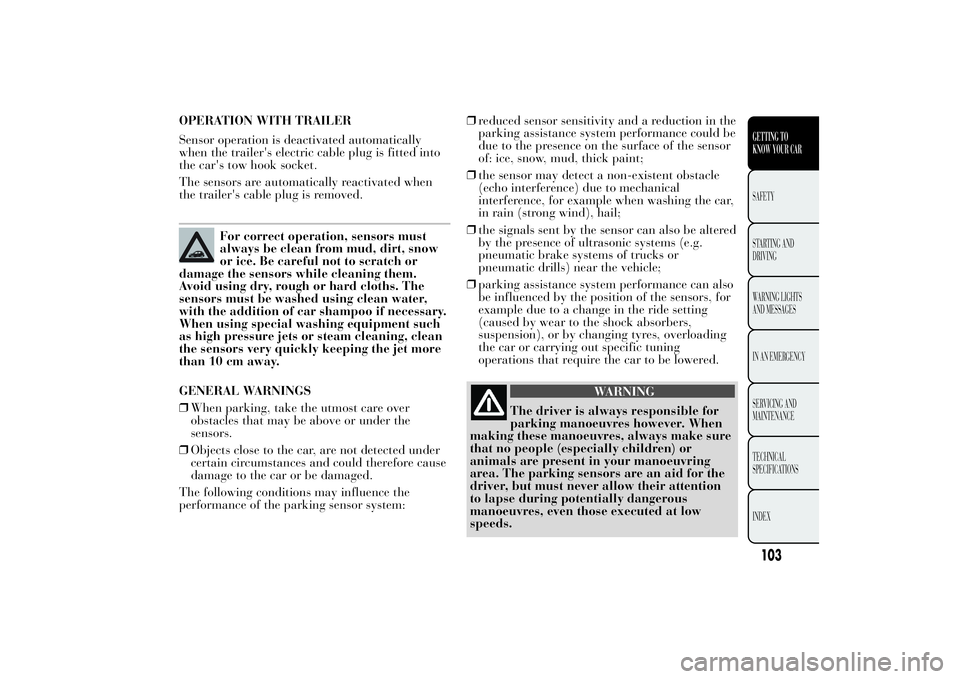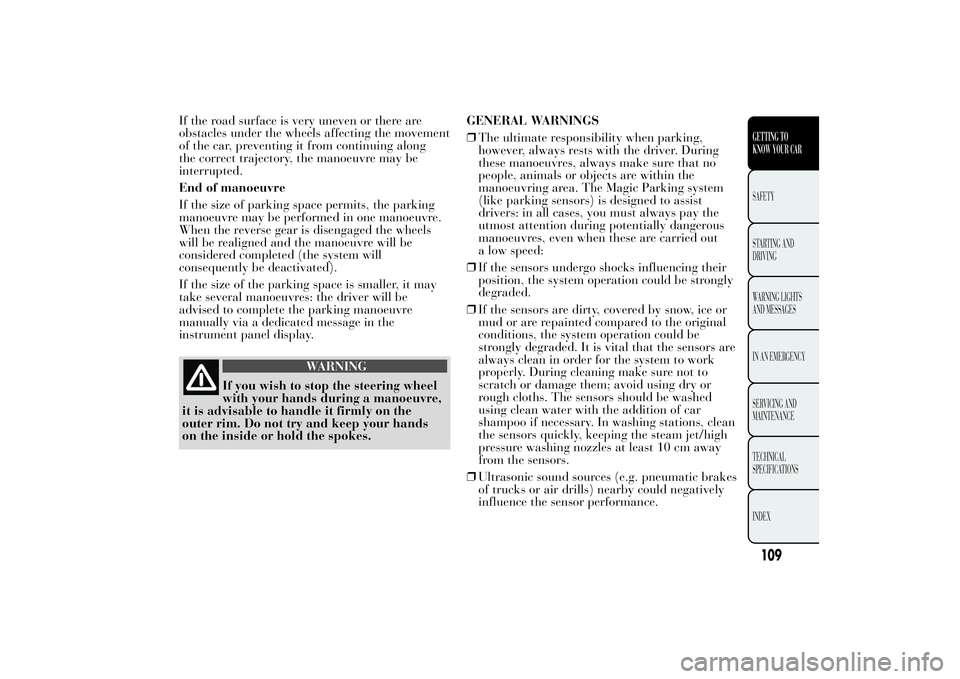brake sensor Lancia Ypsilon 2012 Owner handbook (in English)
[x] Cancel search | Manufacturer: LANCIA, Model Year: 2012, Model line: Ypsilon, Model: Lancia Ypsilon 2012Pages: 307, PDF Size: 13.3 MB
Page 105 of 307

OPERATION WITH TRAILER
Sensor operation is deactivated automatically
when the trailer's electric cable plug is fitted into
the car's tow hook socket.
The sensors are automatically reactivated when
the trailer's cable plug is removed.
For correct operation, sensors must
always be clean from mud, dirt, snow
or ice. Be careful not to scratch or
damage the sensors while cleaning them.
Avoid using dry, rough or hard cloths. The
sensors must be washed using clean water,
with the addition of car shampoo if necessary.
When using special washing equipment such
as high pressure jets or steam cleaning, clean
the sensors very quickly keeping the jet more
than 10 cm away.
GENERAL WARNINGS
❒When parking, take the utmost care over
obstacles that may be above or under the
sensors.
❒Objects close to the car, are not detected under
certain circumstances and could therefore cause
damage to the car or be damaged.
The following conditions may influence the
performance of the parking sensor system:❒reduced sensor sensitivity and a reduction in the
parking assistance system performance could be
due to the presence on the surface of the sensor
of: ice, snow, mud, thick paint;
❒the sensor may detect a non-existent obstacle
(echo interference) due to mechanical
interference, for example when washing the car,
in rain (strong wind), hail;
❒the signals sent by the sensor can also be altered
by the presence of ultrasonic systems (e.g.
pneumatic brake systems of trucks or
pneumatic drills) near the vehicle;
❒parking assistance system performance can also
be influenced by the position of the sensors, for
example due to a change in the ride setting
(caused by wear to the shock absorbers,
suspension), or by changing tyres, overloading
the car or carrying out specific tuning
operations that require the car to be lowered.
WARNING
The driver is always responsible for
parking manoeuvres however. When
making these manoeuvres, always make sure
that no people (especially children) or
animals are present in your manoeuvring
area. The parking sensors are an aid for the
driver, but must never allow their attention
to lapse during potentially dangerous
manoeuvres, even those executed at low
speeds.
103GETTING TO
KNOW YOUR CARSAFETY
STARTING AND
DRIVING
WARNING LIGHTS
AND MESSAGES
IN AN EMERGENCY
SERVICING AND
MAINTENANCE
TECHNICAL
SPECIFICATIONS
INDEX
Page 107 of 307

OPERATION
The assisted parking manoeuvre can only be
activated with the instrument panel on and at
speeds below about 30 km/h and consists of the
following stages:❒Activation:pressing the button
starts the
search.
❒Search:through side sensors, the system
continuously searches for a free parking space,
suitable for the car's dimensions. The driver
chooses on which side of the road they intend to
park using the direction indicators (if no
information is available from the direction
indicators or hazard warning lights, the search
takes place on the passenger side).
IMPORTANT The SEARCHING is disabled if,
after about 10 minutes, a suitable parking space
has not been found.
❒Identification:if the system identifies a free
parking space that is a suitable size for the
car, it signals its presence and indicates
the actions required for starting the manoeuvre.
❒Manoeuvre:the driver is asked to engage
reverse gear, release the steering wheel and
manage the accelerator, brake and clutch (in the
case of manual gearbox) or accelerator and
brake (in the case of automatic gearbox) (for
versions/markets, where provided). During the
reverse parking manoeuvre, the system manages
the steering wheel automatically. According to
the parking space, the manoeuvre may end
through reversing or further manoeuvres, both
in forward gear and in reverse, may be
necessary. After the first manoeuvre, when the
rear buzzer sounds continuously, the driver
is requested to disengage reverse and engage the
forward gear. If this is not enough, when the
fig. 80
L0F0036
fig. 81
L0F0037
105GETTING TO
KNOW YOUR CARSAFETY
STARTING AND
DRIVING
WARNING LIGHTS
AND MESSAGES
IN AN EMERGENCY
SERVICING AND
MAINTENANCE
TECHNICAL
SPECIFICATIONS
INDEX
Page 110 of 307

Identifying a parking space
If the system identifies a suitable parking space
between two stationary vehicles or between other
obstacles (e.g. objects with an extensive side
surface such as vehicles, boxes, etc.) it will signal
that it has found a parking space that can be
entered fig. 83.
If the position reached is already suitable at the
beginning of the manoeuvre, the system will
advise the driver to engage reverse gear, otherwise
it will request further forward motion.
At the request to engage reverse gear the driver
should stop the car and engage reverse in order to
confirm the wish to start the manoeuvre. If the
driver continues driving, after about 10 metres the
system will no longer consider the parking space
identified and will start the search for new
suitable space.Manoeuvre
The driver controls the movements of the car
using accelerator pedal, brake and clutch (only on
versions with manual gearbox) whilst the system
automatically manages the steering system to
enter the parking space identified in the best
possible way.
During the manoeuvre it will be possible to take
advantage of the information coming from the
parking sensors (when reversing it is advisable to
reach the area where the rear sensors provide a
continuous tone signal), but it is always advisable
to keep an eye on the surrounding area.
The car can be stopped during the manoeuvre
and, whilst remaining stationary, reverse gear can
temporarily be released (for example, to allow a
pedestrian to pass through the area of the
manoeuvre).
The speed should be less than about 7 km/h
during the manoeuvre, otherwise the parking
manoeuvre will be interrupted.
If the driver carries out a voluntary or involuntary
action on the steering during the parking
manoeuvre (touching it or preventing its
movement), the manoeuvre will be interrupted.
fig. 83
L0F1002
108GETTING TO
KNOW YOUR CAR
SAFETY
STARTING AND
DRIVING
WARNING LIGHTS
AND MESSAGES
IN AN EMERGENCY
SERVICING AND
MAINTENANCE
TECHNICAL
SPECIFICATIONS
INDEX
Page 111 of 307

If the road surface is very uneven or there are
obstacles under the wheels affecting the movement
of the car, preventing it from continuing along
the correct trajectory, the manoeuvre may be
interrupted.
End of manoeuvre
If the size of parking space permits, the parking
manoeuvre may be performed in one manoeuvre.
When the reverse gear is disengaged the wheels
will be realigned and the manoeuvre will be
considered completed (the system will
consequently be deactivated).
If the size of the parking space is smaller, it may
take several manoeuvres: the driver will be
advised to complete the parking manoeuvre
manually via a dedicated message in the
instrument panel display.
WARNING
If you wish to stop the steering wheel
with your hands during a manoeuvre,
it is advisable to handle it firmly on the
outer rim. Do not try and keep your hands
on the inside or hold the spokes.GENERAL WARNINGS
❒The ultimate responsibility when parking,
however, always rests with the driver. During
these manoeuvres, always make sure that no
people, animals or objects are within the
manoeuvring area. The Magic Parking system
(like parking sensors) is designed to assist
drivers: in all cases, you must always pay the
utmost attention during potentially dangerous
manoeuvres, even when these are carried out
a low speed:
❒If the sensors undergo shocks influencing their
position, the system operation could be strongly
degraded.
❒If the sensors are dirty, covered by snow, ice or
mud or are repainted compared to the original
conditions, the system operation could be
strongly degraded. It is vital that the sensors are
always clean in order for the system to work
properly. During cleaning make sure not to
scratch or damage them; avoid using dry or
rough cloths. The sensors should be washed
using clean water with the addition of car
shampoo if necessary. In washing stations, clean
the sensors quickly, keeping the steam jet/high
pressure washing nozzles at least 10 cm away
from the sensors.
❒Ultrasonic sound sources (e.g. pneumatic brakes
of trucks or air drills) nearby could negatively
influence the sensor performance.
109GETTING TO
KNOW YOUR CARSAFETY
STARTING AND
DRIVING
WARNING LIGHTS
AND MESSAGES
IN AN EMERGENCY
SERVICING AND
MAINTENANCE
TECHNICAL
SPECIFICATIONS
INDEX
Page 117 of 307

OPERATION WITH TRAILER
The operation of the sensors is automatically
deactivated when the trailer's electric plug
is inserted in the car's tow hook socket. The
sensors are automatically enabled again when the
trailer's cable plug is removed.
IMPORTANT If you wish to leave the tow hook
fitted when there is no trailer, it is advisable to go
to a Lancia Dealership to have the system updated
because the tow hook could be detected as an
obstacle by the centre sensors.
GENERAL WARNINGS
During parking manoeuvres, pay the utmost
attention to any obstacles that could be located
above or below the sensors.
Under certain circumstances close objects located
in front of or behind the car may not be detected
and could therefore cause damage to the car or
be damaged themselves.
The following conditions may influence the
performance of the parking sensor system:
❒Reduced sensor sensitivity and a reduction in
the parking assistance system performance
could be due to the presence on the surface of
the sensor of: ice, snow, mud, thick paint
❒The sensor may detect a non-existent obstacle
(echo interference) due to mechanical
interference, for example when washing the car,
in rain, (strong wind), hail.❒The signals sent by the sensors can also be
altered by the presence of ultrasonic systems
(e.g. pneumatic brake systems or pneumatic
drills) near the vehicle.
❒The performance of the parking assistance
system may also be affected by the position of
the sensors. For example, if the geometry is
altered (as a result of wear of the shock
absorbers, suspension) or the tyres are changed,
the vehicle is too heavily laden, specific tuning
is carried out that lowers the car.
❒The detection of obstacles at the top part of the
car may not be guaranteed because the system
detects obstacles that could cause an impact
with the car in the bottom part.
115GETTING TO
KNOW YOUR CARSAFETY
STARTING AND
DRIVING
WARNING LIGHTS
AND MESSAGES
IN AN EMERGENCY
SERVICING AND
MAINTENANCE
TECHNICAL
SPECIFICATIONS
INDEX
Page 166 of 307

Rain sensor failure
(for versions/markets, where provided)
The warning light switches on (together with a
message on the display) when a rain sensor failure
is detected.
Parking sensor failure
(for versions/markets, where provided)
The warning light switches on (together with a
message on the display) when a parking sensor
failure is detected.
Dusk sensor failure
(for versions/markets, where provided)
The warning light switches on (together with a
message on the display) when a dusk sensor
failure is detected.
Engine oil pressure sensor failure
Versions with multifunction display:the engine oil
pressure sensor failure is indicated by the
instrument panel warning light switching on.
Versions with reconfigurable multifunction
display:the engine oil pressure sensor failure is
indicated by the display icon switching on.
EXTERNAL LIGHT FAILURE
(amber)
This warning light switches on (on some versions
together with a message and a symbol in the
display) if a fault is detected in one of the
following lights:
❒daytime running lights (DRLs) (for versions/
markets, where provided);
❒side lights;
❒direction indicators;
❒rear fog lamps;
❒number plate lights;
❒brake lights (for versions with multifunction
display only).
The failure relating to these lights could be: one or
more blown bulbs, a blown protection fuse or a
break in the electrical connection.REAR FOG LIGHTS (amber)
The warning light switches on when the rear fog
lights are activated. The LED over the button
will also light up.
164
GETTING TO KNOW
YOUR CAR
SAFETY
STARTING AND
DRIVINGWARNING LIGHTS
AND MESSAGESIN AN EMERGENCY
SERVICING AND
MAINTENANCE
TECHNICAL
SPECIFICATIONS
INDEX